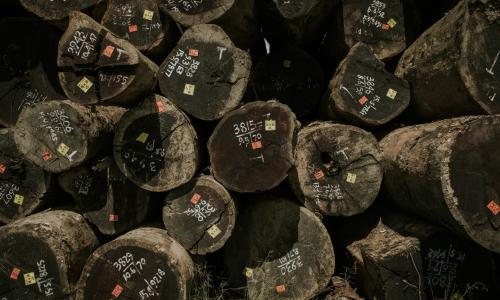
Places to Watch Second Edition: Five Indicated Illegal Logging Area in Indonesia
This second part features the 5 Places to Watch for indications of illegal logging within the period between 11 March to 30 June 2018.
#1 Indications of Illegal Logging in a 336.24-hectare Convertible Production Forest (HPK) for the Expansion of a Plantation and Agricultural Area in the Pesisir Selatan Regency, West Sumatra
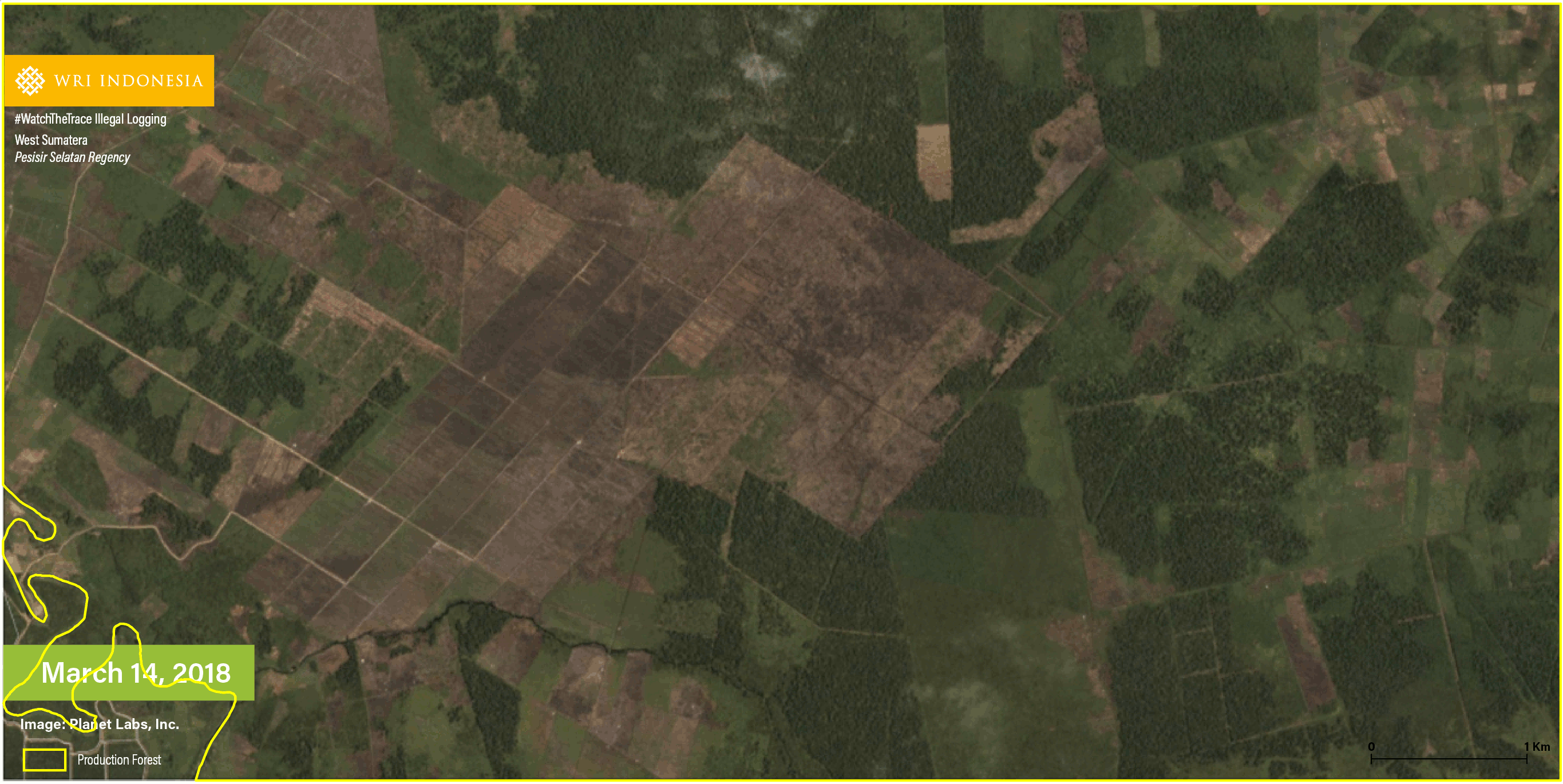
Indications of illegal logging in an area of 336.24 hectares have been found in the Lunang District and the Basa Ampek Balai Tapan District. The loss of forest cover in the northwestern part indicates a plantation expansion as it was preceded by the clearing of a vast land and the construction of roads for infrastructure. We are currently unable to determine whether the land clearing was done for a palm oil plantation, an industrial forest, or other commodities as planting has not begun. Meanwhile, there are indications that land clearing in the northeastern part is done for small-scale dry land farming, expanding from an existing agricultural area.
This area is an extension of the Area of Indication of illegal logging #2 in the first of the Places to Watch series – the Area of Indication has expanded from 58 hectares in the previous edition to 336.24 hectares with a rise of logging rate from 23 hectares/month to 96 hectares/month. Illegal logging and the utilization of forest for non-forestry activities are still the main challenges of environmental and forest management and protection in the Pesisir Selatan Regency.
2 Indications of Illegal Logging in a 348.21-hectare Protected Forest from Land Clearing for Agriculture or Fish Farming in the Banyuasin Regency, South Sumatra
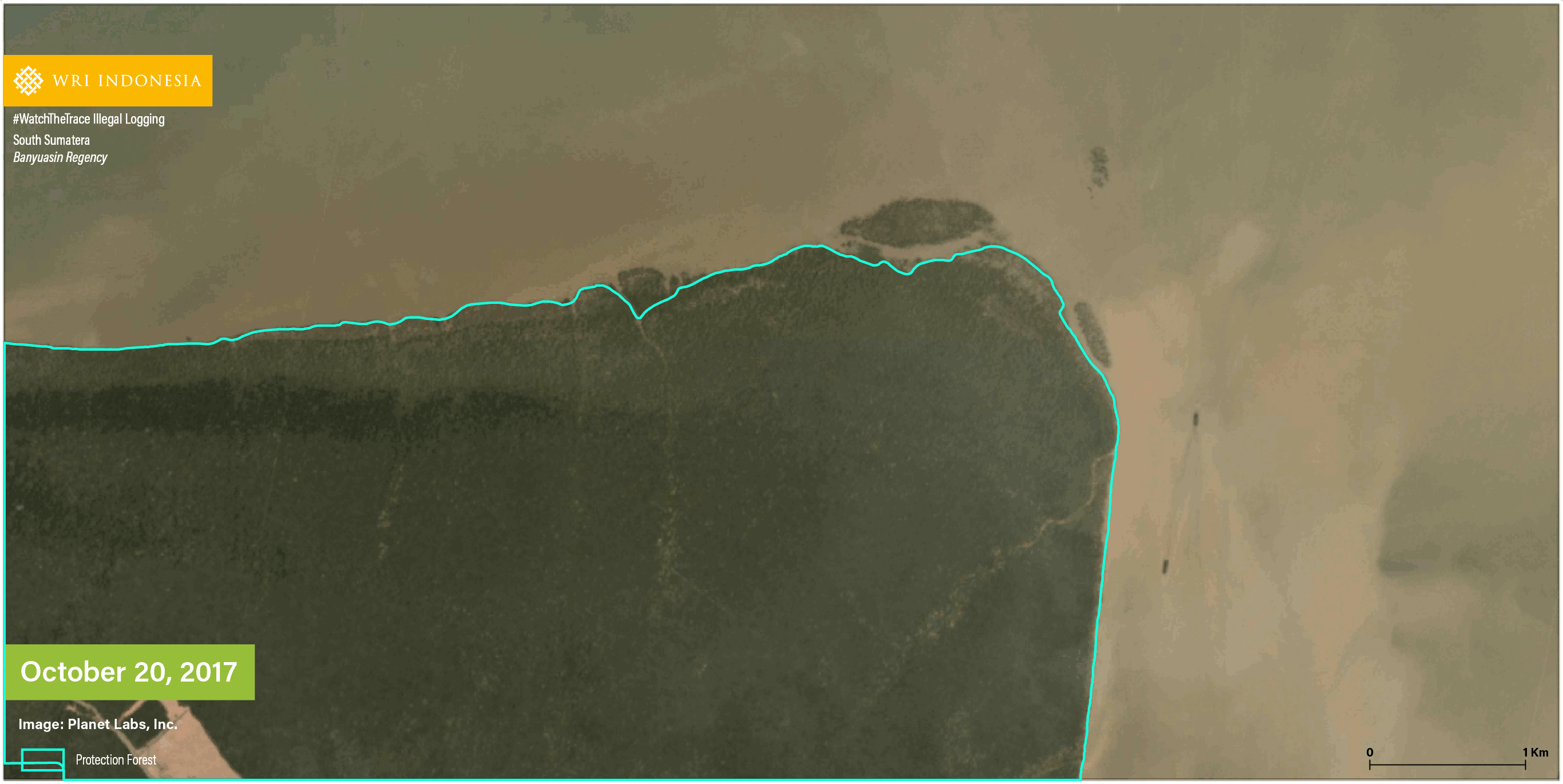
The Area of Indication is a mangrove forest located in the Banyuasin Dua Regency. There have been no signs of in the area. However, the typology of the clearing based on the size of the Area of Indication, the regular land clearing pattern and its proximity with an estuary indicates that it is designated for agriculture or fish farming.
A report of Project-JICA (2014) shows that one of the main causes of the degradation of the mangrove ecosystem in the Sembilang National Park in the Banyuasin Regency is the construction of fish farms. The National Park is adjacent to and shares a costal line with the Protected Forest Area where the Area of Indication is found. Moreover, the Proceedings of the X Annual National Seminar on the Results of the Fisheries and Marine Research in 2013 shows a significant increase in fish farming areas in 2003-2007 in the Banyuasin Regency, mostly from the conversion of mangrove forest.
3 Indications of Illegal Logging in a 208.08-hectare Production Forest Area for Agricultural Land Clearing in the Berau Regency, East Kalimantan
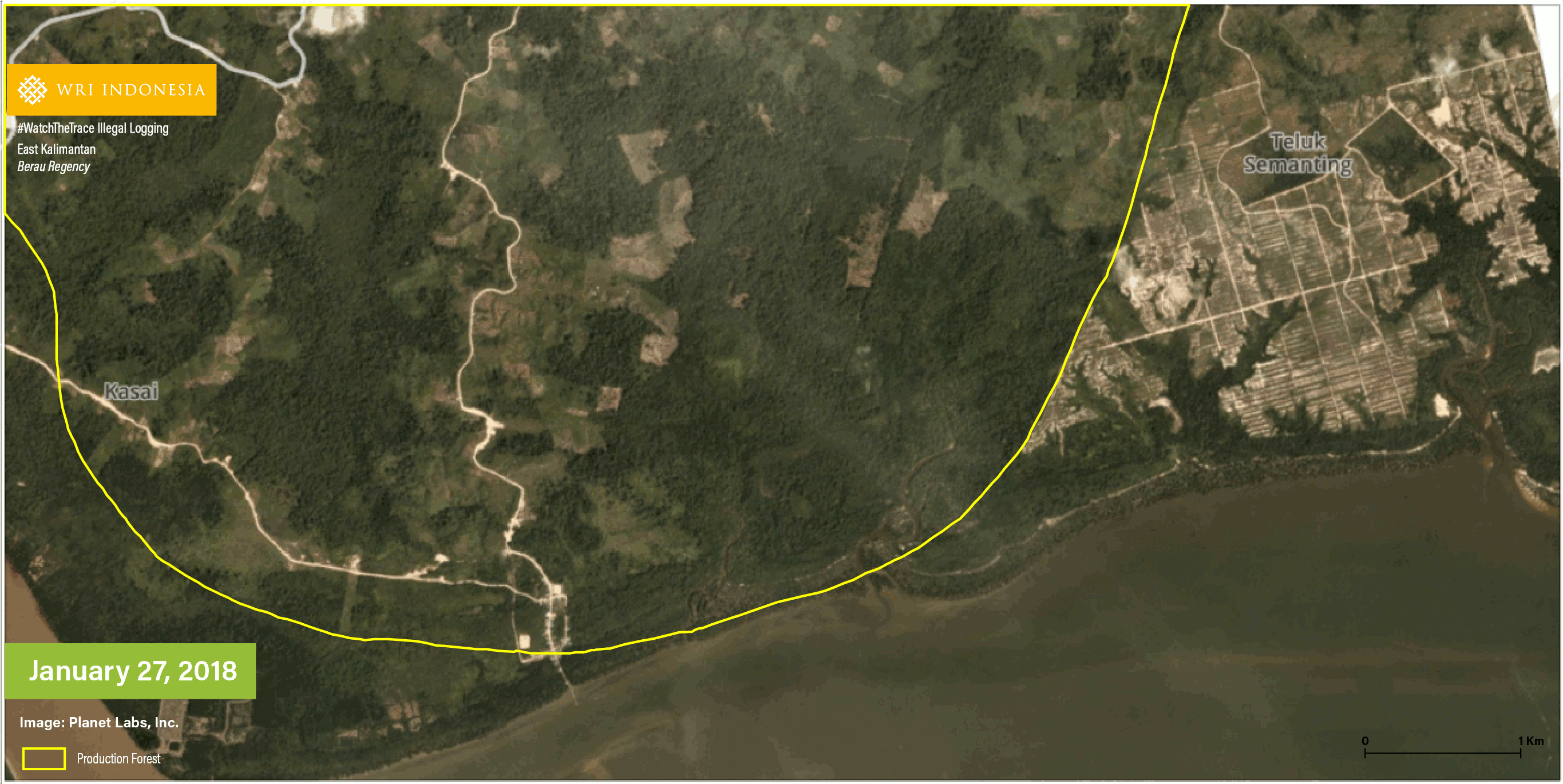 Another Area of Indication is found in the Pulau Derawan District. Loss of forest cover occurs in the eastern part, which directly borders a plantation area and has been cleared, indicating that the logging is done for the establishment/expansion of a plantation. The construction of roads for infrastructure shows that the clearing is carried out by a large-scale farmer.
Another Area of Indication is found in the Pulau Derawan District. Loss of forest cover occurs in the eastern part, which directly borders a plantation area and has been cleared, indicating that the logging is done for the establishment/expansion of a plantation. The construction of roads for infrastructure shows that the clearing is carried out by a large-scale farmer.
Meanwhile, the loss of forest cover in the northern part shows indications of land clearing by logging and burning for plantation. It is concluded that the forest has been logged prior to the burning based on the satellite imagery from 1 May, which shows smooth, light brown soil with no signs of tree remnants. The satellite imagery from 16 June shows a hint of dark brown and a small patches of black resembling a burn scar on the cleared area, indicating land burning toward the end of the land clearing.
In Berau's Regional Medium-Term Development Plan 2016-2021, forest clearing for non-forestry purposes, such as oil palm plantation, is identified as a threat for forest sustainability in the forest area of Berau, potentially contributing to climate change. Kehati's report also shows indications of and potential for significant oil palm plantation development in the forest area of Berau.
4 Indications of Illegal Logging in a 98.1-hectare Permanent Production Forest Area (HP) and a Limited Production Forest Area (HPT) for Agricultural Land Clearing in the West Tanjung Jabung Regency, Jambi
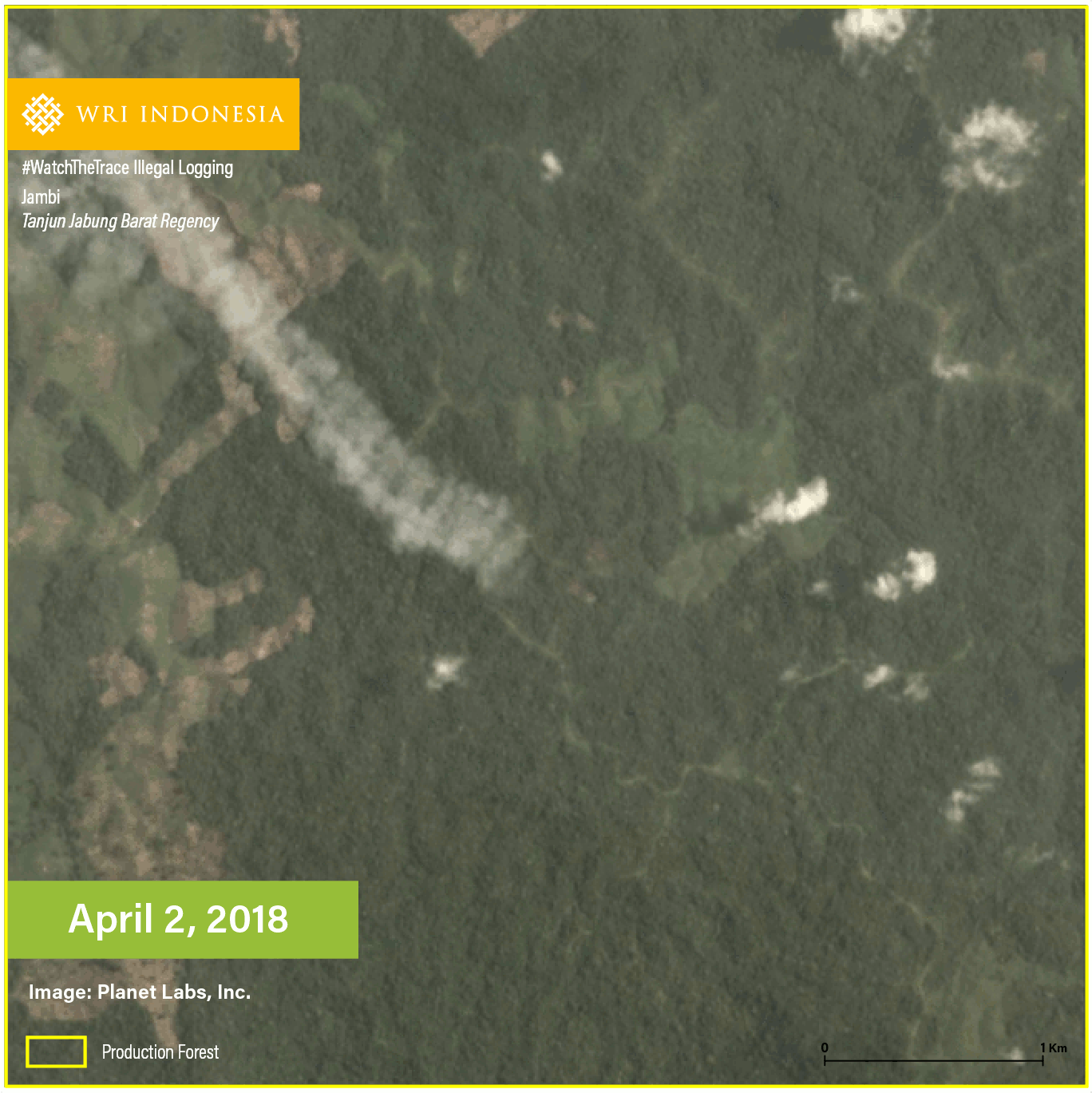
This Area of Indication is located in the Batang Asam District. The irregularity, spread and small size of the pattern of forest cover loss indicates dryland clearing for agricultural purposes. The absence of a network of roads around the Area of Indication and its considerable distance from any settlement are indications of shifting agriculture.
A research by Bogor Agricultural University shows a growing demand for land in the West Tanjung Jabung Regency. This is partly due to the designation of the Regency as a transmigration destination since 1990. Such growing demand has prompted the people to take their economic activities into the forest areas to survive.
5 Indications of Illegal Logging in a 76.59-hectare of Wildlife Sanctuary for Agricultural Land Clearing in Bukit Rimbang Bukit Baling, Kuantan Singigi Regency, Riau
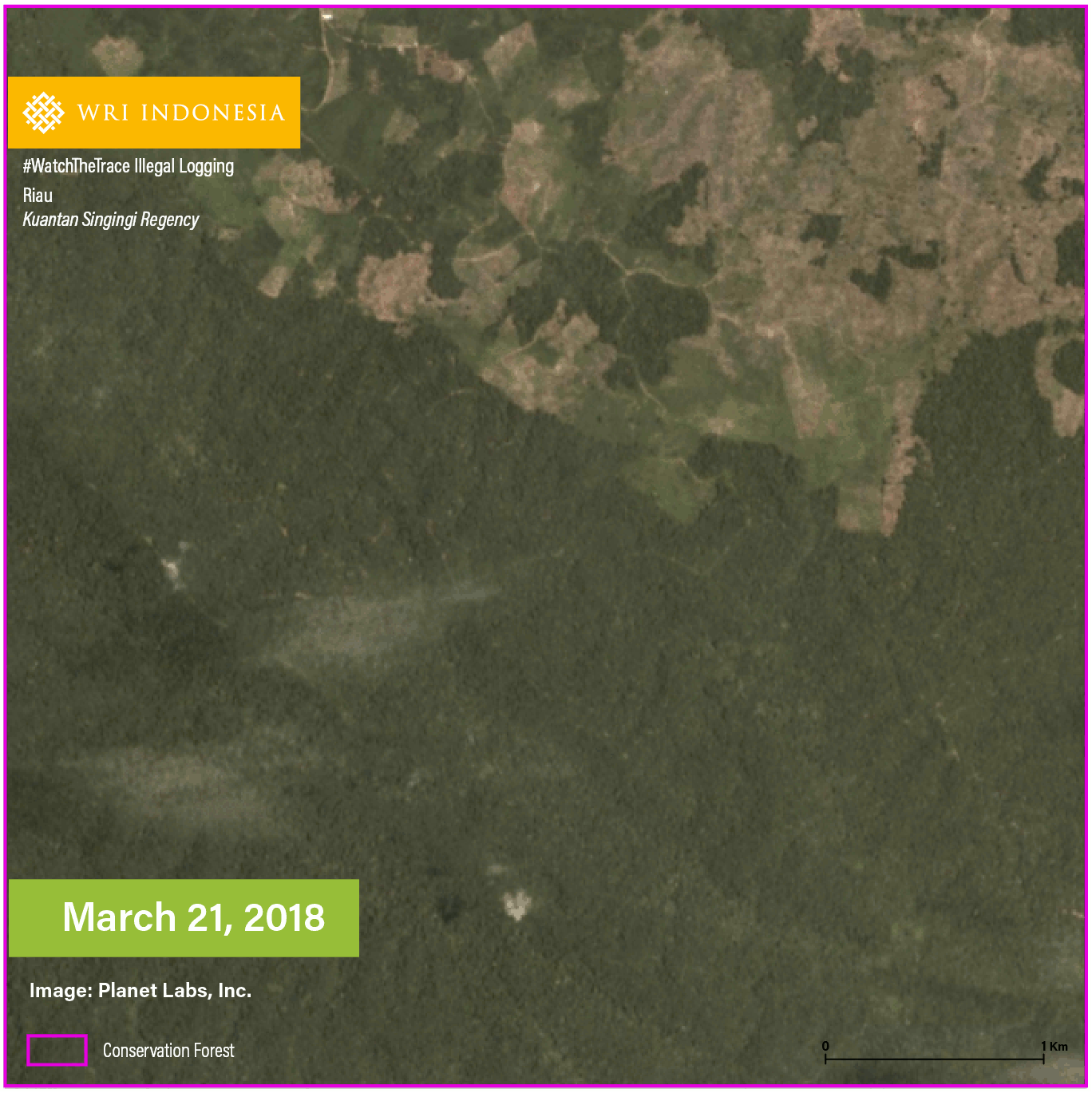
The Area of Indication is found in the Singigi Hilir District. The irregularity, small size and spread of the pattern of forest cover loss indicates dryland clearing for agricultural purposes. The absence of a network of roads around the Area of Indication and its considerable distance from any settlement are indications of shifting agriculture instead of permanent.
A study on the Bukit Rimbang Bukit Baling Wildlife Sanctuary finds that at least 15 villages are adjacent to the sanctuary. This shows that the people are highly dependent on the wildlife sanctuary. Furthermore, rampant illegal logging has been report in the Rimbang Baling Wildlife Sanctuary.
Next Step
While these Places to Watch are determined based on indications only, they can be used in determining priority areas for monitoring. To that end, the following steps need to be taken immediately.
1. Field Verification and Action to Prevent Illegal Logging from Expanding Beyond the Five Areas of Indication
All five areas of indication are not the first in their respective region to suffer from illegal logging. Rather, these are extension/expansion from ongoing activities. These areas of indication are facing the risk of continued logging expansion into the surrounding forests.
Thus, the forest area protection authorities in the Areas of Indication must immediately conduct field verification and take action to prevent further illegal logging and illegal forest utilization. Community contribution in providing information from the field may help in the verification process. As the forest area that has been cleared and utilized for non-forestry activities grows larger, its management and restoration will be more challenging. Area of Indication #1 in particular must be focused on as it was identified as Area of Indication #2 in the previous edition with an increasing rate of logging.
2. Upon verification, the handling process must take into account the socio-economic background of the local communities.
Illegal logging across the five places is closely associated with small-scale economic activities. As such, upon verification, the handling process must take into account the socio-economic background of the local communities. The handling mechanism may include logical and fair conflict resolution, social forestry and law enforcement schemes. In addition, it is also necessary to trace the perpetrators back to the mastermind (intellectual player) who has reaped the ultimate benefit of illegal logging.